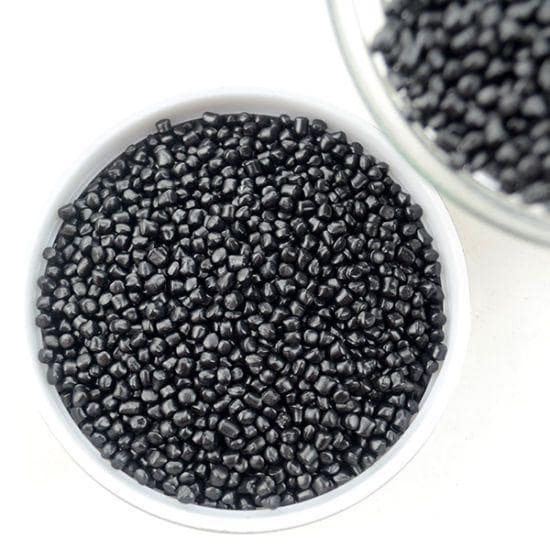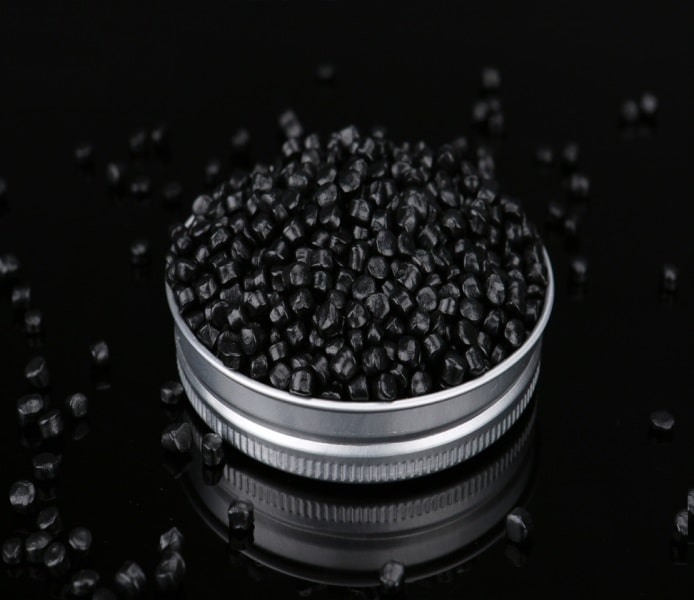Black masterbatch
This product is used as a pigment and anti-ultraviolet ray in the polymer industry, but the black masterbatch is used to produce various products. These products include the production of polyethylene pipes and fittings, all kinds of plastic bags, and the plastic injection industry.
Black masterbatch is one of the reinforcements and supplements that has many applications today. Generally, a combination of carbon black and polymers is used to produce black masterbatch. The standard for using carbon black in the plastic industry is only carbon black with plastic grade, which is specific for use and mixing with polymer, and for this reason, it does not change the properties of the polymer. Black masterbatch is also used to produce other products, which include:
• Food containers
• Production of standard pipes and fittings in various sizes
• Film production
• Types of plastic bags, especially garbage bags
• Products made from plastic injection
• Producing strong cardboard plastics and using them in various applications


What characteristics should the equipment used to produce black masterbatch have?
Black masterbatch is one of the pigments used in the plastic industry to color products. This pigment is originally prepared from materials such as carbon black, and due to its anti-ultraviolet properties, it is used in the production of products such as polyethylene pipes and fittings, plastic bags, and the plastic injection industry. This substance is known as one of the most important industrial pigments due to its good dispersibility and strong resistance to light.
Also, due to its anti-ultraviolet characteristics, black masterbatch is used in the production of products such as plastic covers for machinery and industrial equipment, outdoor furniture, sunbeds, and protection of electronic components and cables. It is also used to color products such as sports equipment, toys and household appliances.
Another advantage of Black Masterbatch is that it does not stimulate skin sensitivity and has high color stability against adverse conditions such as sunlight, temperature fluctuations and environmental changes. Due to the unique characteristics of this pigment, it is used in the production of products that seek to resist the sun, light, heat and other adverse conditions.
In general, the equipment used to produce high-quality masterbatch should be able to mix the existing compounds by creating the right force. Also, this equipment should be able to control the temperature of the compounds well. Because at low temperatures, the polymer and additives are not well combined and will not have the required quality. At high temperatures, polymers become pasty and molten, in which case the possibility of breaking their main chains will increase, and in this way, the substance will lose its adhesion and viscosity. In general, the best time to add additives to black masterbatches is when the desired polymer has a very high viscosity. Because it is only at this time that the additives are well combined and the material will have a good viscosity.
Advantages of Black Masterbatch
Due to its special physical and chemical properties, black masterbatch has many advantages for various uses. Some of these benefits include:
1.High resistance to sunlight and ultraviolet (UV) radiation, which makes the black masterbatch color stable and reliable, and resistant to decay and color loss.
2.High color stability against adverse conditions such as temperature and humidity changes, this feature makes masterbatch black pigment used as a stable and reliable pigment in many industries.
3.Non-stimulation of skin sensitivity and no side effects on human health, which makes it used in the production of food, medicine and health products.
4.This pigment has a low deformation against changes in temperature and pressure, which makes the products dyed with this pigment perform well in harsh industrial conditions.
5.It has a high mixing ability with plastic materials, which makes it blend well with the base material in the production process of plastic products, and as a result, it has a high processing capability.
Therefore, due to the unique characteristics of Black Masterbatch, it is used in various industries such as polymer industries, automobile manufacturing, food, pharmaceutical and health products, detergents and in general wherever a pigment with high stability and resistance against adverse conditions is needed. And if there is no stimulation of skin sensitivity and human health and the ability to mix with plastic materials, black masterbatch is known as a suitable option.
All kinds of black masterbatch
1. PE Black Masterbatch: This type of black masterbatch is used to produce plastic products such as polyethylene films, polyethylene pipes, plastic chairs and plastic shopping baskets.
2. PP Black Masterbatch: This type of black masterbatch is used to produce plastic products such as polypropylene bags, polypropylene syringes, polypropylene containers and plastic containers.
3. UV Black Masterbatch: This type of black masterbatch is used to produce plastic products such as polyethylene pipes, PVC boards, plastic chairs and polyethylene films.
4. High Pigment Black Masterbatch: This type of black masterbatch is used to produce plastic products with a very dark and deep color such as car parts, plastic seats, plastic plates and PVC windows.
5. Recyclable Black Masterbatch: This type of black masterbatch is used to produce recyclable and reusable plastic products such as plastic containers, shopping baskets and plastic bags.
6. Moisture Absorbing Black Masterbatch: This type of black masterbatch is used to produce plastic products with the ability to absorb moisture, such as plastic bags for storing food, pharmaceutical and cosmetic products.
7. Conductive Black Masterbatch: This type of black masterbatch is used to produce plastic products with the ability to move electrons, such as electronic components and electrical and electronic industries.
8. Heat Resistant Black Masterbatch: This type of black masterbatch is used to produce heat resistant plastic products such as automotive products and interior components of buildings.
Factors influencing the production of black and white masterbatch:
Black and white masterbatch are widely used in the plastic industry to give color to the plastic material. Here are some factors that can influence the production of black and white masterbatch:
Type and quality of the pigments and additives: Pigments are the most important component of masterbatch, and the type and quality of pigments can greatly affect the final product. The type of pigment and additives can also impact the processing of the masterbatch.
Processing conditions: Processing conditions, such as temperature, pressure, and residence time, can also affect the final product’s properties. For example, too high a temperature can cause the pigment to degrade, while too low a temperature can cause the pigment to not disperse evenly in the polymer matrix.
Polymer matrix: The polymer matrix used in the masterbatch can also affect the final product’s properties. The type of polymer and its molecular weight can impact the dispersibility of the pigment in the matrix and its overall performance.
Manufacturing equipment: The manufacturing equipment used for producing black and white masterbatch can also affect the product quality. The type and quality of the equipment, such as the extruder and mixer, can impact the dispersibility of the pigment and additives in the polymer matrix.
Quality control measures: The quality control measures taken during the production process can also affect the product quality. Regular testing of the raw materials, intermediate products, and final product can help ensure consistent quality.
Overall, the production of black and white masterbatch requires careful consideration of these factors to ensure that the final product meets the desired quality and performance requirements.
